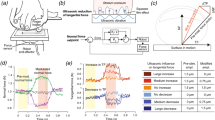Abstract
Current touchscreen technology makes for intuitive human-computer interactions but often lacks haptic feedback offered by conventional input methods. Typing text on a virtual keyboard is arguably the task in which the absence of tactile cues imparts performance and comfort the most. Here we investigated the feasibility of modulating friction via ultrasonic vibration as a function of the pressing force to simulate a tactile feedback similar to a keystroke. Ultrasonic vibration is generally used to modulate the sliding friction which occurs when a finger moves laterally on a surface. We found that this method is also effective when the exploratory motion is normal to the surface. Psychophysical experiments show that a mechanical detent is unambiguously perceived in the case of signals starting with a high level of friction and ending to a low friction level. A weaker effect is experienced when friction is increasing with the pressure exerted by the finger, which suggests that the mechanism involved is a release of the skin stretch accumulated during the high-friction state.
Access this chapter
Tax calculation will be finalised at checkout
Purchases are for personal use only
Similar content being viewed by others
References
Hoggan, E., Brewster, S.A., Johnston, J.: Investigating the effectiveness of tactile feedback for mobile touchscreens. In: Proceedings of the SIGCHI Conference on Human Factors in Computing Systems, pp. 1573–1582. ACM (2008)
Ma, Z., Edge, D., Findlater, L., Tan, H.Z.: Haptic keyclick feedback improves typing speed and reduces typing errors on a flat keyboard. In: 2015 IEEE World Haptics Conference (WHC), pp. 220–227. IEEE (2015)
Murmann, G., Bauer, G.: Low profile switch. US Patent 4,467,160, 21 August 1984
Weir, D.W., Peshkin, M., Colgate, J.E., Buttolo, P., Rankin, J., Johnston, M.: The haptic profile: capturing the feel of switches. In: Proceedings of 12th International Symposium on Haptic Interfaces for Virtual Environment and Teleoperator Systems, HAPTICS 2004, pp. 186–193. IEEE (2004)
Harris, R.H.: Catastrophically buckling compression column switch and actuator. US Patent 3,699,296, 17 October 1972
English, G.: Computer keyboard with flexible dome switch layer. US Patent 5,212,356, 18 May 1993
Chen, P.C.: Computer keyboard key switch. US Patent 5,457,297, 10 October 1995
Poupyrev, I., Maruyama, S.: Tactile interfaces for small touch screens. In: Proceedings of the 16th Annual ACM Symposium on User Interface Software and Technology, pp. 217–220. ACM (2003)
Kaaresoja, T., Brown, L.M., Linjama, J.: Snap-crackle-pop: tactile feedback for mobile touch screens. In: Proceedings of Eurohaptics, vol. 2006, pp. 565–566. Citeseer (2006)
Zoller, I., Lotz, P., Kern, T.A.: Novel thin electromagnetic system for creating pushbutton feedback in automotive applications. In: Isokoski, P., Springare, J. (eds.) EuroHaptics 2012, Part I. LNCS, vol. 7282, pp. 637–645. Springer, Heidelberg (2012)
Kim, J.R., Tan, H.Z.: Haptic feedback intensity affects touch typing performance on a flat keyboard. In: Auvray, M., Duriez, C. (eds.) EuroHaptics 2014, Part I. LNCS, vol. 8618, pp. 369–375. Springer, Heidelberg (2014)
Visell, Y., Giordano, B.L., Millet, G., Cooperstock, J.R.: Vibration influences haptic perception of surface compliance during walking. PLoS ONE 6(3), e17697 (2011)
Watanabe, T., Fukui, S.: A method for controlling tactile sensation of surface roughness using ultrasonic vibration. In: IEEE ICRA, pp. 1134–1139, May 1995
Biet, M., Giraud, F., Lemaire-Semail, B.: Squeeze film effect for the design of an ultrasonic tactile plate. IEEE Trans. Ultrason. Ferroelectr. Freq. Control 54(12), 2678–2688 (2007)
Winfield, L., Glassmire, J., Colgate, J.E., Peshkin, M.: T-pad: Tactile pattern display through variable friction reduction. In: World Haptics Conference, pp. 421–426. IEEE (2007)
Wiertlewski, M., Leonardis, D., Meyer, D.J., Peshkin, M.A., Colgate, J.E.: A high-fidelity surface-haptic device for texture rendering on bare finger. In: Auvray, M., Duriez, C. (eds.) EuroHaptics 2014, Part II. LNCS, vol. 8619, pp. 241–248. Springer, Heidelberg (2014)
Johansson, R.S., Flanagan, J.R.: Coding and use of tactile signals from the fingertips in object manipulation tasks. Nat. Rev. Neurosci. 10(5), 345–359 (2009)
Bicchi, A., Scilingo, E.P., De Rossi, D.: Haptic discrimination of softness in teleoperation: the role of the contact area spread rate. IEEE Trans. Robot. Autom. 16(5), 496–504 (2000)
Di Luca, M., Knörlein, B., Ernst, M.O., Harders, M.: Effects of visual-haptic asynchronies and loading-unloading movements on compliance perception. Brain Res. Bull. 85(5), 245–259 (2011)
Maeno, T., Kawamura, T., Cheng, S.C.: Friction estimation by pressing an elastic finger-shaped sensor against a surface. IEEE Trans. Robot. Autom. 20(2), 222–228 (2004)
Acknowledgments
The authors wish to thank Stéphane Viollet for valuable insights. They are also grateful for the technical support provided by Marc Boyron and Julien Diperi. This research was partly supported by the Openlab PSA-Aix- Marseille University and partly by CNRS basic funding.
Author information
Authors and Affiliations
Corresponding author
Editor information
Editors and Affiliations
Rights and permissions
Copyright information
© 2016 Springer International Publishing Switzerland
About this paper
Cite this paper
Monnoyer, J., Diaz, E., Bourdin, C., Wiertlewski, M. (2016). Ultrasonic Friction Modulation While Pressing Induces a Tactile Feedback. In: Bello, F., Kajimoto, H., Visell, Y. (eds) Haptics: Perception, Devices, Control, and Applications. EuroHaptics 2016. Lecture Notes in Computer Science(), vol 9774. Springer, Cham. https://doi.org/10.1007/978-3-319-42321-0_16
Download citation
DOI: https://doi.org/10.1007/978-3-319-42321-0_16
Published:
Publisher Name: Springer, Cham
Print ISBN: 978-3-319-42320-3
Online ISBN: 978-3-319-42321-0
eBook Packages: Computer ScienceComputer Science (R0)




